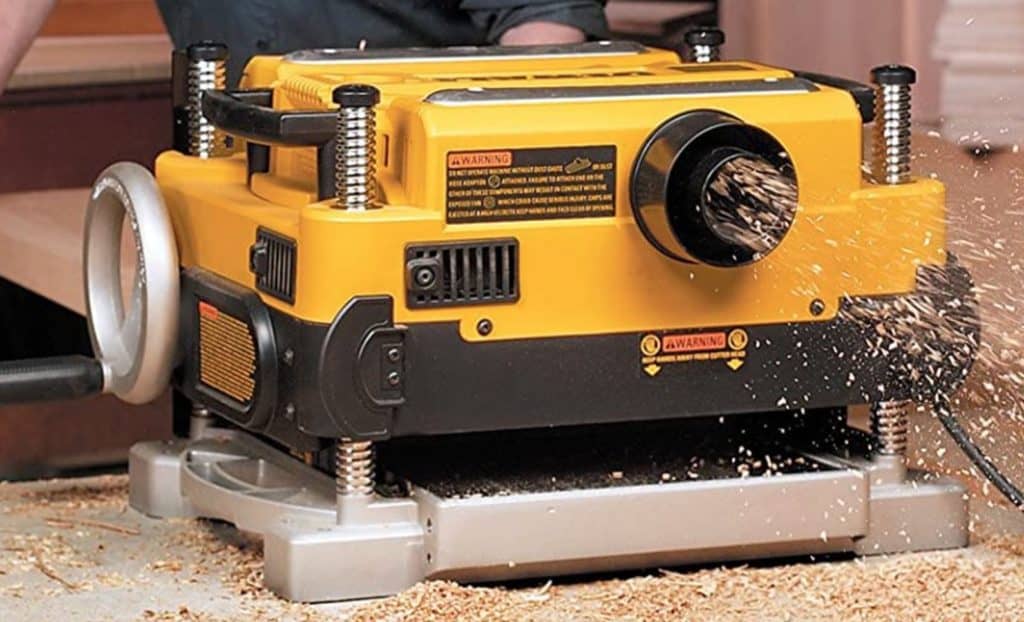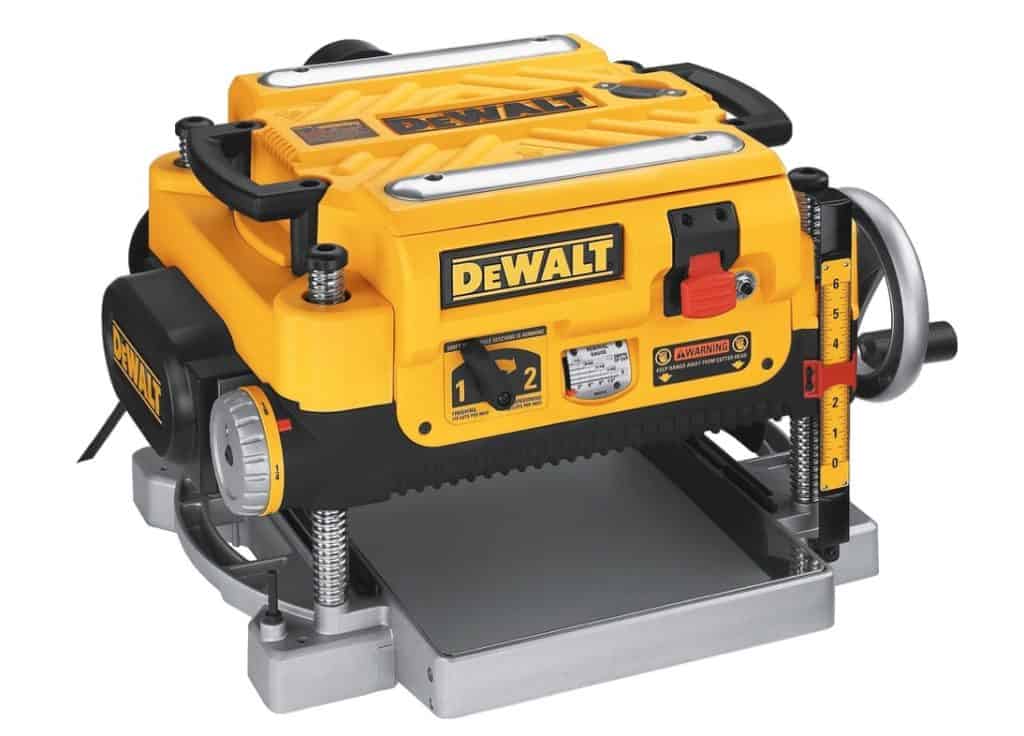If you are working on your first advanced woodworking project, you might have seen the instructions call for a thickness planer. Your first inclination might be that you don’t need one and you can get away with a belt sander, jack plane, or something similar. Is that practical, or do you need a thickness planer?
Let’s dig into these tools a bit.
What Is A Thickness Planer?
A thickness planer — sometimes known as a thicknesser — is a tool that flattens and/or thins the long side of boards. If you need a length of wood that is very flat and a consistent thickness from one end to the other, a thickness planer is the tool you need.
The operation of a thickness planer is relatively straightforward: a board is fed into one end, it is pulled by the feeding roller, it is then cut to size with a trimming head, and then it’s pulled out with the outgoing roller. You are essentially getting a board that is flat on one side and making it thinner while making it flat on the other side.
You’d assume the the board can then be turned over and fed through the machine again, but that’s not the case with a planer as it requires one flat side to begin with! Think about it — the tool would not have been able to produce an accurate cut if the board was bowed or uneven. To put it another way, the planer requires a flat bottom side so that the top size of the board can be precisely cut so it too becomes both flat and consistent. If the bottom of the board is not flat, the top will be consistent… but not flat!
The commercial version of a thickness planer would be a planing mill, which is something you’d find in a lumber yard that was, say, making flooring. You wouldn’t have a “planing mill” in your garage, even if your planer is basically the doing the same job.
Here’s a good basics video on planers…
Do You Need A Thickness Planer?
The ideal buyer for a thickness planer is an enthusiast to advanced woodworker who needs to regularly thin/flatten lengths of wood.
Generally speaking, you’d want to run a board that isn’t perfectly flat through a jointer first, to establish that flat side, so the assumption is normally that you’d want to buy jointer first.
Should I Buy A Planer or Jointer?
Keep in mind two things. First, if you are proficient with hand tools you might be able to doing the jointer work by hand where doing planer work by hand is a considerable challenge. Second, if you are buying boards that are relatively flat to begin with you can run them lightly on one side then the other (and repeat a few times) on the planer to approximate the job a jointer would have done.
So our advice would be to get the thickness planer first and then a jointer down the road, but individual needs will be different for each woodworker.
And, of course, you could simply opt for hand tools and do without the thickness planer but getting the long side of a board to be absolutely parallel to the other side requires high degree of skill and patience.
If can only afford or make room for a thicknesser or jointer, then ask yourself this: Which would you rather do: flatten a board by hand or level a board by hand? Most people would opt for the former, which means the planer is the one to buy.
The Best Thickness Planers For Home Shops
Here are some top benchtop planer picks for home workshops…

Dewalt Thickness Planer DW735
The top pick in home shop thickness planers in 2020 has been the Dewalt DW735, a 13-inch (12.5 inch actual), 2-speed planer that sells for about $575.
This bolt-down, benchtop planer is the current number one seller on Amazon, so any issues with it would have been discovered well ahead of your purchase. It has about 1000 positive reviews, which is a great sign, plus Dewalt really is a powerhouse at this price point for garage wood shop buyers.
Features include:
- 3 cutting blades operating at 20,000 RPM
- 15 AMP motor
- 110V power source
- 2-speed design: 96 or 179 cuts per inch
- Max board width: 12.5 inches
- Max board height: 6 inches
- Rear-mounted fan-assisted chip ejection vacuum (hose compatible)
- Unit weight: 92 pounds
- Max cut depth: 1/8 inch

Upgrade Pick: The upgrade pick for this thickness planner is the Dewalt DW735X, which is actually the same model, but it includes in-feed and out-feed tables (see them on our picture at the top) which reduce board snipe and increase stability of the lumber as it goes into and out of the tool. You’ll end up spending an extra $80 or so to get the “X” model, so it’s a nice upgrade but not mandatory. You can learn more about it in the DW735 manual, which runs through the main features as well as details like the lack of a manual carriage lock (it only has an automatic one).
Budget pick: If you want to save a little money you can look for the Dewalt DW734. This is the 12.5-inch model (pictured at the top), which is the older model design compared to the DW735 and will save you about $80 relatively to our pick.
FAQs
What’s the difference between a jointer and a planer?
The two tools are similar but they have opposite layouts. On a jointer the cutting head is on the bottom of the tool surface where the planer has the cutting head on the top. A jointer is basically a hand planer that’s upside down (and motorized). A planer will take a body that has one flat side and cut the other side to be flat like the other. This means the planer is designed to make a board thinner than it was and parallel. The jointer is designed to make a side of the board flat. In an ideal world you’d use a jointer, then a planer to make sure a board has two parallel sides.
What is planer snipe?
Snipe is the name for how some thickness planers will take off too much material (usually about the thickness of an extra pass) during the first few inches or the last few inches of a cut. A good plane tool should have countermeasures against snipe, like a super stable four-column carriage lock as well as supports (known as sleds) that support the board as they go into and out of the planer.
What’s the difference between the Dewalt DW735 and the DW735X?
These thickness planes are actually the same model with all the same specifications and dimensions, but the DW735X includes in-feed and out-feed tables for increased stability when moving boards in an out of the planer.

